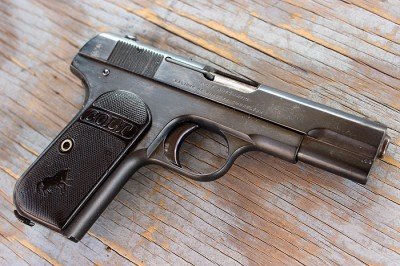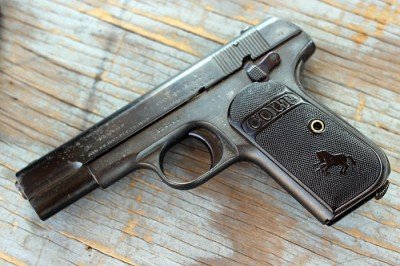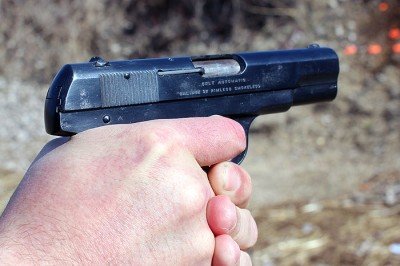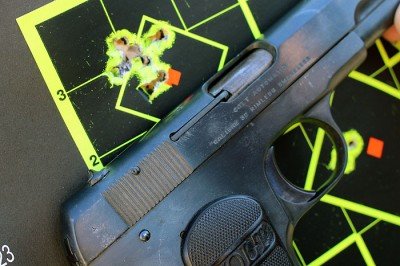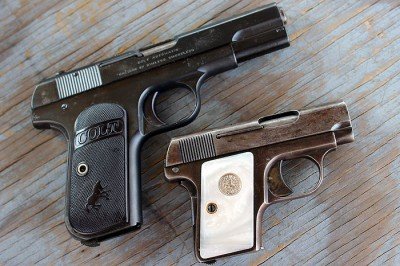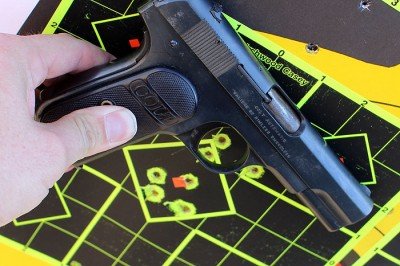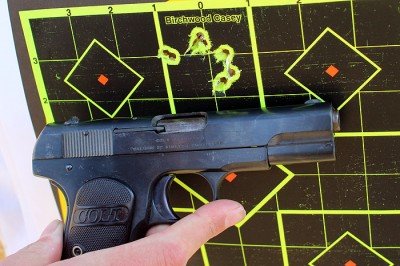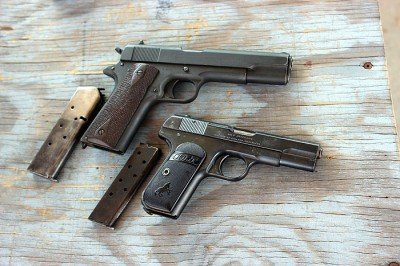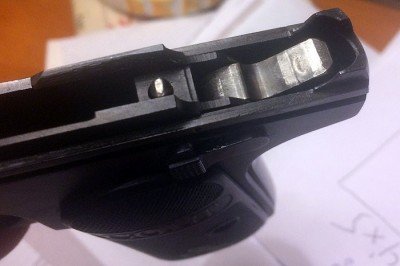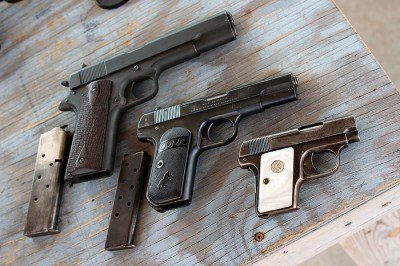Shooting History. We’re firing up a new series here at GunsAmerica. We are working on some historic guns. We’ll shoot them and review them not unlike our new gun reviews (thought the round counts may be a bit lower). If there is a gun you would like to see us cover in this series please let us know in the comments below and we will do our best to procure one.
It was seeing the new production Colt 1903 Pocket Hammerless at SHOT Show this year that got me to thinking about starting this series of articles. So, it makes sense to kick it off with an original 1903.
Specs
Lets take of look at what makes up a Colt 1903 Pocket Hammerless. From here on I will refer to it as the 1903. There was another 1903 Colt Pocket pistol, but it had a hammer. If I can get my hands on one, I will write it up too. The hammer version was not as popular and there were a lot less of them made. But I digress…. Here are some specs:
- Designed by John Browning
- Produced from 1903-45
- Total production more than 500K
- Weight 24oz
- Length 6.75 inches
- Barrel 3.75 inches
- Height 4 inches
- Width .75 inches
- .32 ACP
- Single-action Blowback
- Fixed front blade sight, rear can be drifted
- 8 round magazine
Design
What set the Pocket Hammerless apart from other pistols of its time was how smooth, rounded and concealable it was. Take a look at the pictures. The 1903 has the features that I look for in a concealed carry piece. There is very little here to get hung up when drawn from concealment. The hammerless part of the name is not exactly true. The 1903 does have a hammer–it is covered by the slide, which makes it that much more well suited for concealed carry.
There are a couple of draw backs to the 1903 (especially when comparing it to modern concealed carry pieces). The first are the safeties. If you are a proponent of the no-external-safety-philosophy on a carry piece, this is not the gun for you. The grip safety shouldn’t be a deal breaker; it is easy enough to engage when holding the pistol. The manual safety on the side of the frame is a different story. It is not very easy to flip down/off when the pistol is gripped. The safety doesn’t stick out very far, a product of its ergonomic design. Think of it as a trade off.
The other issue is the magazine release. The 1903 has the type that holds the magazine in on the bottom. This is not the push button that we are all so familiar with that can usually be working with one hand. Dropping the magazine on a 1903 is a two handed job.
Variants
There are a number of variants of the 1903 that need to be mentioned. The first model, the Type I, had a slightly longer barrel and a separate barrel bushing. The Type I was made from 1903 until 1908. The Type II was made from 1908 until 1910. The only major difference was the barrel length changing from 4 inches to 3.75. The Type III was made from 1910 until 1926 and was the largest of the run of the 1903. The Type III had an integrated barrel bushing. The Type IV was last major change and added a magazine disconnect.
The 1903 was also used by the US Military as a General Officer’s side arm. The vast majority of these pistols were similar to the Type IV but were parkerized.
Then there is the 1908 Colt Pocket Hammerless. The 1908 is, for all practical purposes, the exact same as the 1903 except it was chambered in .380 ACP.
The Review Gun
The gun I used for this review is a Type III 1903. It was made in 1916. I have had it for 5 or 6 years. When I picked it up, it was in pretty poor cosmetic condition. It was functionally sound, but there was little to no finish left and pretty extensive pitting on the exterior surfaces of the slide and frame. But the bore was bright, the rifling was decent. The frame to slide fit was tight and everything else worked.
I eventually refinished the pistol and replaced all the springs. Yes, refinishing a gun as old as this is not usually a good idea. But I wanted to be able to use and carry this pistol and it needed to have some sort of finish on it for basic protection. A Type III 1903 is also not exactly a rare gun, either. I hot salt blued it and niter blued the manual safety, grip screw and guide rod. But for some reason I didn’t reblue the barrel. Not sure what I was thinking at the time, but one of these days I will get around to rebluing it, tool.
In a future article for this series I plan to talk about the refinishing vs. leaving it alone schools of thought on historic guns. What I will say now is that there are lots of opinions and that the decision isn’t always a big deal.
Shooting
So how does this 99 year old pony shoot? Like a dream. .32 ACP in this steel framed pistol is extremely pleasant to shoot. Even with the tiny, antique sights it is quick on target and the lack of recoil make follow up shots fast and true. Check out the pictures of the targets I shot for this review. It is easy to place 8 round with in an inch from 15 yards with slow, aimed fire. There are a lot of pistols 90 years younger that can’t do that. Fast fire opens up as would be expected and the diminutive sights are hard to pick up fast. But this pistol points so well that you almost don’t need the sights when shooting from 15 yards or less at a torso sized target. And that is what this gun was originally designed to do.
The trigger on the review gun is great and it was when I bought it. Other than replacing the springs, I have done nothing to the mechanics of this pistol. The trigger feels like a nice 1911 trigger. It has very little creep and breaks at 4 lbs.
This 1903 and the others I have shot, do not like hollow points. They don’t hangup every round or even magazine, but they do tend to get caught on the feed ramp. I have put at least 1,500 rounds of FMJ though this gun since I refinished it about 3 years ago and have had zero malfunctions other than the occasional failure to feed a JHP.
Relevance?
So is the 1903 Colt Pocket Hammerless still a relevant pistol or just a cool old gun? It is a bit of both in my opinion. First there is the caliber. .32 ACP is not my first choice for a defense round. But then again it is not a slouch either. 71 grain FMJs moving around 1,000 ft/s is nothing to laugh at. I am a fan of the FMJ as a carry round for this pistol. I don’t trust the hollow point of this size to open up much or any at all. I had rather have the extra penetration, weight and energy of the FMJ. Of course this is an argument that is older than this pistol and a subject better explored in separate article.
The other negatives are the manual safety and the magazine catch that I talked about above. If you train and shoot your carry pistol or revolver these things can be over came for the most part. That is why I ultimately chose to refinish this pistol. I do occasionally carry this 1903. I tend to think of it as my dress gun. It goes well with a suit. I don’t intend to carry it when I go to the movies though. That didn’t work out so well for John Dillinger when he went to that movie in Chicago with a 1903 in his pocket.
[one_half]
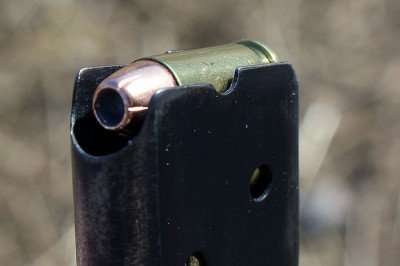
I did shoot some HP for this review and about every 10 or so round would hang up. FMJ is the way to go here.
[/one_half][one_half_last]
[/one_half_last][one_half]
[/one_half][one_half_last]
[/one_half_last][one_half]
[/one_half][one_half_last]
[/one_half_last][one_half]
[/one_half]
